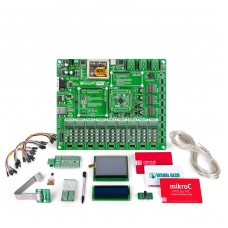mikroLAB for PIC L
The EasyPIC PRO board maximises the connectivity potential of the high pin count chips, placing a large number of peripherals at your disposal. The large number of examples and libraries provided in the compiler will allow you to jump-start your development.
Choose the language that suits you:
mikroC is the most popular choice, and you'll be able to find a lot of free code and tutorials – as well as freelance opportunities — that use or ask for mikroC.
mikroBasic is the best choice for beginners because of the simple syntax and clear code.
mikroPascal encapsulates strong data types, very nice syntax, and has probably the best balance between simplicity and control.
About PIC
When it comes to 8-bit microcontrollers, Microchip's PIC is number one. First introduced in 1976, today there are more than two PICs for every person on this planet. Replacing something as ubiquitous is next to impossible, so PIC expertise will continue to be in high demand.
Even though 32-bit MCUs are getting increasingly important, 8-bit PICs are still as relevant as ever. There are many applications where anything beyond an 8-bit MCU is overkill, a waste of resources. Not only that, but engineers are actually finding new applications for this 40-year old architecture in this IoT age. And Microchip is keeping it up with the times by developing 8-bit PICs with modern high-speed core-independent peripherals.
Specification
| Architecture | PIC (8-bit) |
Includes
- EasyPIC PRO v7 development board
- mikroC, mikroBasic or mikroPascal for PIC (installation on USB flash + license activation card)
- FREE BONUS:Visual GLCD (installation on USB flash + license activation card)
- EasyPROTO board
- SmartPROTO board
- EasyTEST board
- Proto click
- Character LCD 2x16 with blue backlight
- Graphic LCD 128x64 with TouchPanel
- Plastic Pen for TouchPanel
- DS1820 Temperature Sensor
- Wire Jumpers Female to Female (15cm length, 10pcs)
- Wire Jumpers Male to Male (15cm length, 10pcs)
- Wire Jumpers Female to Male (15cm length, 10pcs)
Enter the code in the box below:















